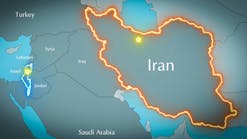AN INTERVIEW WITH STEVE MOORE, CEO OF BRS RESOURCES INC.
OIL & GAS FINANCIAL JOURNAL: The Po Valley in Italy, while not clearly understood by investors in the US, is a large gas play with well timed world class opportunities. How did you get into the play and what potential does it have in shaping the future of the European gas market?
STEVE MOORE: The Po Valley in northern Italy is one of the most prolific natural gas provinces onshore Europe, where more than 27 trillion cubic feet of gas has been produced since the early 1950s. Little exploration and production activity has occurred onshore Italy in the last 15 years. The Po Valley had been overlooked until Italy joined the European Union and broke the AGIP / ENI monopoly on production. We believe considerable gas reserves remain in the ground and utilizing recently acquired 3D seismic data, BRS Resources through its investment in AleAnna Resources LLC, plans to unlock the potential of the Po Valley's conventional gas reserves. The Po Valley remains one of the best places – if not the best place – to find conventional gas reserves onshore Europe.
For a small E&P company like BRS Resources, there are not too many opportunities in the world like the Po Valley where we can garner as much exploration acreage and exposure to potential reserves. BRS Resources is one of three companies – and the only publicly traded company – that owns AleAnna Resources, which holds more than 800,000 acres in eight permitted areas and three application areas in the core producing provinces of Italy. I consider BRS Resources and AleAnna Resources as early entrants to the reemergence of the Po Valley as a significant gas producing province.
OGFJ: Is Italy a good place to invest given the political and financial problems facing the country?
MOORE: There are political and financial risks everywhere, not just in Italy. Italy holds some great opportunity for several reasons: 1) Natural gas has been trading for more than $10 per mcf in Europe for the last several years; more recently, gas has been traded for as much as $14 per mcf in Italy. (By comparison, in the US gas has been trading around $4 per mcf in recent years). 2) Italy is extremely dependent on foreign energy imports for its energy requirements. Natural gas is the primary energy resource consumed in Italy, yet the country imports more than 90% of its daily energy needs – most of which comes from Russia via pipeline (Any E&P activities that boost domestic gas production will be a huge benefit for Italy for both financial and security reasons). 3) An infrastructure is in place to deliver natural gas to the end user. Pipelines are prevalent throughout the Po Valley, unlike many emerging markets where infrastructure has to be constructed - i.e., gathering systems, pipelines, and processing facilities - at considerable time and expense.
Further, Italy is in critical need of investment capital to reinvigorate its economy. I can't think of any industry more willing to invest in Italy right now than the energy industry. BRS Resources' investment in Italy is a win-win for the country and BRS. Energy investment will provide (1) new tax revenue for the government - i.e., the government holds the mineral rights and royalties for any gas production, (2) employment for Italian citizens, and (3) increased energy security.
The Po Valley remains one of the best places – if not the best place – to find conventional gas reserves onshore Europe.
OGFJ: You recently completed a private placement in which you raised $6 million. Talk to us about the use of proceeds and how you plan to allocate the capital.
Po Valley in Italy
MOORE: In November, BRS Resources carried out a $6 million private placement with Carlson Capital through two hedge funds they manage. BRS Resources used part of the raised capital to acquire another 10% of AleAnna Resources. BRS Resources now owns 17.35% of AleAnna Resources. The remainder of the raised capital will be used as working capital to fund upcoming capital investments in Italy – i.e., our share of the cost to drill AleAnna's first well and two new 3D seismic surveys, all of which are scheduled for 2012.
OGFJ: Can you provide us an update on the status of your first permitted well and what effect this has on your company, and the current natural gas markets in Italy?
MOORE: In mid-November AleAnna received formal approval from the Italian government to drill its first well – Gallare 6d – in the Po Valley. At the same time, AleAnna finalized a land usage agreement with the landowner. AleAnna is quickly pushing ahead with drilling plans and expects to spud within the next 60 – 90 days, depending upon rig availability. A bottomhole location has already been selected using the processed 3D data and construction of the drilling pad will commence in mid-December.
OGFJ: What role has 3-D seismic played in developing your exploration program?
MOORE: AleAnna is one of the first E&P companies to extensively use state-of-the-art 3D seismic technology onshore in the Po Valley. We believe using this technology will have a huge impact on our drilling success. The processed 3D data has imaged significant structures and has generated numerous prospects from the first shoot already. Geology in the Po Valley is somewhat analogous to the US Gulf Coast with complex subsurface faulting and trapping. In the last 25 years, trillions of cubic feet of gas have been discovered along the Gulf Coast with the use of 3D seismic techniques, and we expect similar success in the Po Valley.
AleAnna's 3D seismic shoots are playing a significant role in the development of our well locations for both our 2012 and 2013 drilling program. In September 2011, we (through AleAnna) completed a second 3D seismic acquisition survey on the Ponte Del Diavolo exploration permit area, in the Po Valley, Italy. AleAnna now has more than 260 sq km of newly acquired 3D data from its first two permit areas: Corte Dei Signori and Ponte Del Diavolo. A third 3D seismic survey on the Ponte Dei Grille exploration permit, also in the Po Valley, is planned for early in 2012.
OGFJ: Many European countries are taking a negative look at natural gas drilling techniques. Does Italy share this same understanding of the drilling process?
MOORE: Just like in the US, a lot of concerns are being raised in Europe over horizontal drilling and the associated hydraulic fracing that goes along with it. Fears of water contamination, however unwarranted, have slowed drilling in many European countries. The Po Valley, however, is a conventional natural gas play that has utilized vertical drilling techniques for decades. Hydraulic fracturing and horizontal drilling applications are not required in this play. The wells are very shallow, between 5,000 feet and 8,000 feet in depth, and are highly predicable and pose little to no environmental risk. As for the Italian government, we work very closely with the government to ensure that all of our processes and procedures adhere to all their rules and regulations. I believe that our attention to detail and ability to work closely with government officials is what led to the approval of our first permit.
OGFJ: What does your well and exploration program look like for 2012?
MOORE: As mentioned previously, we plan to drill our first well in early 2012. I should remind your readers that the Po Valley has been explored for more than 50 years. This is important because in addition to the seismic data we have been acquiring, our company has amassed well data from thousands of wells that have been producing in the region to combine with our 3D data to select our target areas. We use the 3D seismic data to image the precise area most conducive to hydrocarbon accumulation. We have identified a number of large geological anomalies. We want to establish an aggressive drilling program and work closely with the Italian government to optimize the permitting program while adhering to all regulatory and environmental concerns.
OGFJ: What new developments should investors expect from BRS Resources in 2012?
MOORE: In 2012 investors should expect to see significant activity from BRS Resources on the drilling front. We have participated in a number of seismic shoots, and data collection efforts to ensure our feet are under us before we embark on our relatively aggressive drill plan. Opportunities are plentiful and the environment is ripe for our company to prosper in Italy. Natural gas prices continue to hover around $12 per mcf. We have an aggressive exploration and drilling program throughout fiscal 2012 that will provide additional opportunities on our eleven concessions in the years to follow and greater upside potential for our shareholders.
More Oil & Gas Financial Journal Current Issue Articles
More Oil & Gas Financial Journal Archives Issue Articles
View Oil and Gas Articles on PennEnergy.com




